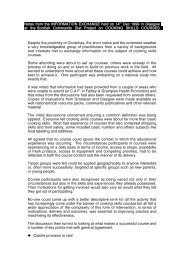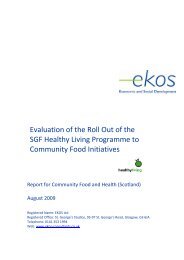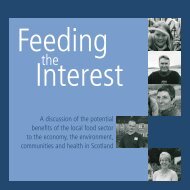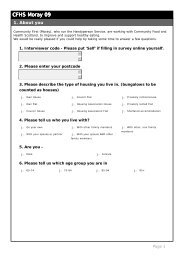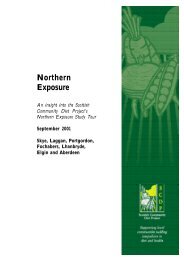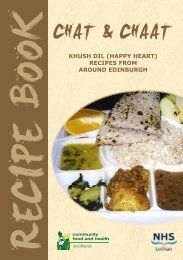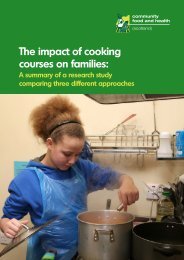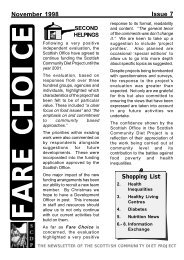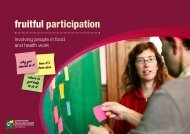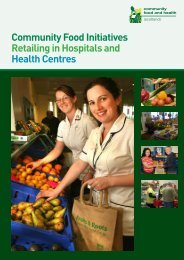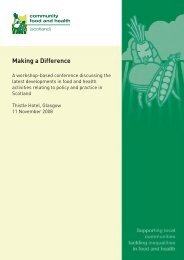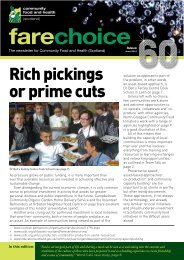North Glasgow Youth Food Guidelines and Healthy Eating Toolkit
North Glasgow Youth Food Guidelines and Healthy Eating Toolkit
North Glasgow Youth Food Guidelines and Healthy Eating Toolkit
Create successful ePaper yourself
Turn your PDF publications into a flip-book with our unique Google optimized e-Paper software.
NORTH GLASGOW<br />
YOUTH FOOD<br />
GUIDELINES AND<br />
HEALTHY EATING<br />
TOOLKIT
1 - 2<br />
CONTENTS<br />
THE CASE FOR HEALTHY EATING<br />
<strong>North</strong> <strong>Glasgow</strong> <strong>Youth</strong> <strong>Food</strong> <strong>Guidelines</strong> <strong>and</strong> <strong>Healthy</strong> <strong>Eating</strong> <strong>Toolkit</strong><br />
1. THE CASE FOR HEALTHY EATING AND OPINIONS<br />
FROM NORTH GLASGOW<br />
2. OUR NORTH GLASGOW YOUTH FOOD GUIDELINES<br />
3. HEALTHY EATING INFORMATION<br />
4. HEALTHY TUCK SHOPS<br />
5. RECIPES AND TASTER IDEAS<br />
- NO COOK RECIPES<br />
- SAVOURY SNACKS<br />
- TAKEAWAYS AT HOME<br />
- HEALTHIER CAKES<br />
- PACKED LUNCHES<br />
6. GAMES AND ACTIVITIES TO PROMOTE HEALTHY EATING<br />
- DUMP THE JUNK<br />
- HOW HEALTHY IS YOUR EATING?<br />
- COOKERY CLASSES AND TASTER SESSIONS<br />
- FOOD LABELS: WHAT’S A LOT AND WHAT’S A LITTLE?<br />
- BUDGETING<br />
- GROW YOUR OWN<br />
7. SUPPORT AND FURTHER INFORMATION<br />
8. EXTRAS<br />
- SAMPLE POSTERS AND LEAFLETS<br />
- LOCAL FRUIT BARRAS<br />
- FOOD HYGIENE INFORMATION<br />
An unhealthy diet can lead to obesity, poor dental health <strong>and</strong><br />
chronic diseases such as heart disease, diabetes <strong>and</strong> some cancers.<br />
As a nation Scots aren’t eating enough fruit <strong>and</strong> vegetables, <strong>and</strong><br />
are eating too many fatty <strong>and</strong> sugary foods.<br />
The recent Schools Health Survey showed young<br />
people in <strong>North</strong> <strong>Glasgow</strong> to have the poorest intake<br />
of fruit <strong>and</strong> vegetables in <strong>Glasgow</strong>, with only 29% of<br />
pupils aged 12-15 eating the target 5 a day, <strong>and</strong> 21%<br />
reporting that they ate no fruit or vegetables the<br />
previous day! <strong>North</strong> <strong>Glasgow</strong> pupils were also more<br />
likely to drink fizzy drinks than others in <strong>Glasgow</strong>,<br />
with 43% of pupils reporting that they had a non<br />
diet fizzy drink at lunchtime.<br />
A poor diet is not only linked with physical health,<br />
but also feelings of self esteem - the survey showed<br />
lower self esteem in those who ate less fruit <strong>and</strong><br />
vegetables, didn’t regularly eat breakfast <strong>and</strong><br />
drank more fizzy juice.<br />
Opinions in <strong>North</strong> <strong>Glasgow</strong>:<br />
Results from the Consultation <strong>and</strong> Survey Monkey<br />
From April 2009 to February 2010 we worked with<br />
40 young people in 5 youth groups alongside cookery<br />
classes <strong>and</strong> 69 young people <strong>and</strong> youth workers<br />
responded to a survey monkey. We wanted to know:<br />
• What are your food issues?<br />
• Do you want food guidelines?<br />
• How can we help you to use these guidelines?<br />
• What do you think should be in the food guidelines?<br />
The content of this resource is based on what young<br />
people <strong>and</strong> youth workers told us, <strong>and</strong> the guidelines<br />
have been developed to support healthy eating in<br />
youth clubs. We held a focus group in March 2010<br />
where 15 young people <strong>and</strong> youth workers commented<br />
on the content <strong>and</strong> design of these guidelines, as well<br />
as tasting some of the recipes included.<br />
Findings from the survey monkey<br />
Young people weren’t too sure if there was a need for<br />
healthy eating guidelines or not, but 69% thought they<br />
would affect them in a good way, <strong>and</strong> no one thought<br />
it would be a bad thing!<br />
60% of youth workers think there is definitely a need<br />
for healthy eating guidelines, <strong>and</strong> 100% think these<br />
will affect the young people they work with in a<br />
positive way.<br />
50% of youth clubs have someone trained in food<br />
hygiene, <strong>and</strong> only 23% have someone trained in<br />
nutrition. Only 35% of youth clubs have the facilities<br />
<strong>and</strong> equipment to run cookery courses <strong>and</strong> just over<br />
½ of youth clubs do some healthy eating activities<br />
at the moment.<br />
The three biggest things that young people would like<br />
the guidelines to contain are the opportunity to try<br />
new things, games <strong>and</strong> activities around healthy eating<br />
<strong>and</strong> practical cookery sessions.<br />
<strong>Youth</strong> workers need support to roll out these<br />
guidelines: the three biggest things they asked for<br />
were staff training in nutrition, a toolkit of healthy<br />
eating activities <strong>and</strong> recipes, <strong>and</strong> funding.
3 - 4 <strong>North</strong> <strong>Glasgow</strong> <strong>Youth</strong> <strong>Food</strong> <strong>Guidelines</strong> <strong>and</strong> <strong>Healthy</strong> <strong>Eating</strong> <strong>Toolkit</strong><br />
OUR NORTH GLASGOW<br />
YOUTH FOOD GUIDELINES:<br />
These have been developed to tackle your key food issues identified<br />
by the consultation:<br />
• Access to healthy food<br />
• Cost <strong>and</strong> convenience of unhealthier options<br />
• Lack of cooking skills <strong>and</strong> the opportunity to try new things<br />
• Concern over the amount of junk food you eat <strong>and</strong> the health<br />
risks of this<br />
1. Young people should be involved in decisions around what<br />
food <strong>and</strong> drink is available<br />
2. Tuck shops should have healthy options, including<br />
access to water<br />
3. Cookery classes <strong>and</strong>/or taster sessions should be made<br />
available where possible<br />
4. <strong>Healthy</strong> food should be promoted, e.g. posters <strong>and</strong><br />
information on sugar contents of tuck shop items<br />
5. Games <strong>and</strong> activities around nutrition should be used regularly<br />
to help young people learn about healthy eating<br />
6. Space to grow your own fruit <strong>and</strong> vegetables should be made<br />
available where possible<br />
The following information <strong>and</strong> activities in this toolkit aim to support<br />
you to implement these guidelines in your youth organisation.<br />
HEALTHY EATING INFORMATION
5 - 6 <strong>North</strong> <strong>Glasgow</strong> <strong>Youth</strong> <strong>Food</strong> <strong>Guidelines</strong> <strong>and</strong> <strong>Healthy</strong> <strong>Eating</strong> <strong>Toolkit</strong><br />
Previous page:<br />
The eatwell plate shows how much of what you eat should<br />
come from each food group. This includes everything you eat<br />
during the day, including snacks. So, try to eat:<br />
• Plenty of fruit <strong>and</strong> vegetables<br />
• Plenty of bread, rice, potatoes, pasta <strong>and</strong> other starchy foods<br />
- choose wholegrain varieties whenever you can<br />
• Some milk <strong>and</strong> dairy foods<br />
• Some meat, fish, eggs, beans <strong>and</strong> other non-dairy sources<br />
of protein<br />
• Just a small amount of foods <strong>and</strong> drinks high in fat <strong>and</strong>/or sugar<br />
Why do we need to eat?<br />
Our food provides us with the energy <strong>and</strong> nutrients<br />
we need to live <strong>and</strong> grow. We need to eat a variety of<br />
foods to get all the nutrients we need, such as vitamins,<br />
minerals <strong>and</strong> protein.<br />
What should we eat?<br />
On the ‘Eatwell’ plate there are no ‘good’ or ‘bad’<br />
foods, but types of foods that we should try to eat<br />
more or less of to achieve a balanced diet. We also<br />
need to make sure we drink enough fluids, such as<br />
water, juice or tea: at least 8 glasses a day.<br />
We should try to eat lots of fruit <strong>and</strong> vegetables;<br />
these are packed with vitamins <strong>and</strong> fibre to help<br />
keep our digestion healthy, at least 5 portions a day.<br />
A portion is roughly the size of what you can hold<br />
in your h<strong>and</strong>, e.g. an apple, half a melon, or 2 big<br />
spoons of cooked vegetables.<br />
We should make sure foods such as bread, rice, pasta<br />
<strong>and</strong> cereals are included in each meal as they provide<br />
most of our body’s energy, fill us up <strong>and</strong> also contain<br />
a lot of fibre: good for our bowels <strong>and</strong> our heart.<br />
Try some wholegrain varieties too as they contain<br />
more fibre, vitamins <strong>and</strong> minerals, <strong>and</strong> give you<br />
longer lasting energy too.<br />
Dairy food, that is milk, cheese <strong>and</strong> yoghurt, is full of<br />
calcium which is very good for our teeth <strong>and</strong> bones.<br />
It can be quite high in fat too though so we should<br />
eat some foods from this group a day, but not lots.<br />
What is HIGH<br />
per 100g?<br />
Meat, fish <strong>and</strong> eggs provide us with protein which is<br />
essential for growth <strong>and</strong> repair of our bodies, <strong>and</strong> also<br />
the mineral iron which helps us to transport oxygen<br />
round our bodies. Vegetarians <strong>and</strong> Vegans can get<br />
protein from nuts <strong>and</strong> pulses, like beans or chickpeas.<br />
We should eat some of these foods every day, but not<br />
too much as they often contain high levels of saturated<br />
fat which can lead to heart disease.<br />
We all love fatty <strong>and</strong> sugary foods, like crisps, fizzy juice,<br />
pastries <strong>and</strong> chocolate, but we should try to limit our<br />
intake of these as they can lead to obesity, tooth decay<br />
<strong>and</strong> contain hardly any of the nutrients our bodies need.<br />
If we do eat these we should try <strong>and</strong> eat these at<br />
mealtimes to limit the damage to our teeth.<br />
Have a look at the further information section to find<br />
out more about healthy eating.<br />
How do we know what is a healthy choice?<br />
The <strong>Food</strong> St<strong>and</strong>ards Agency has developed the ‘traffic<br />
light’ labelling scheme for identifying at a glance which<br />
foods are a healthier choice by making them red,<br />
amber or green for fat, saturated fat, sugar <strong>and</strong> salt.<br />
What do the colours mean?<br />
• Red means HIGH - Indicating that the food is high<br />
in fat, sugars or salt.<br />
• Amber means MEDIUM - Indicating that it is an<br />
ok choice.<br />
• Green means LOW - This makes it a healthier choice.<br />
What is MEDIUM<br />
per 100g?<br />
What is MEDIUM<br />
per 100g?<br />
School Aged Children (5-12)<br />
When children leave home or nursery to attend school,<br />
their opportunities to learn <strong>and</strong> experience food in a<br />
number of environments <strong>and</strong> eating situations grows.<br />
For example they now have the opportunity to choose<br />
their own food from school meal menus, tuck shop etc.<br />
They also have more opportunity to share foods with<br />
friends, <strong>and</strong> to learn about food through lessons <strong>and</strong><br />
experiencing new foods.<br />
Despite this change in environment <strong>and</strong> choice,<br />
children of this age continue to need a varied diet<br />
to help provide the continued supply of energy <strong>and</strong><br />
nutrients needed for their growth. While children in<br />
this age group still have high energy requirements<br />
in relation to their size, good eating habits start<br />
in childhood, <strong>and</strong> children of this age should be<br />
encouraged to make food choices that will<br />
help lead to healthy eating habits later in life.<br />
Adolescence <strong>and</strong> Young Adults (12-19)<br />
Adolescence <strong>and</strong> the first steps into adulthood are<br />
not only a time of physical <strong>and</strong> emotional change<br />
but of the continued development of diet <strong>and</strong> other<br />
health related behaviors. Young people choose foods<br />
for many reasons other than their nutritional content<br />
including peer pressure to eat certain foods, weight<br />
control <strong>and</strong> slimming (whether justified or not) change<br />
in beliefs such as wishing to follow a vegetarian diet<br />
or simply just out of convenience.<br />
Growth <strong>and</strong> development happens very quickly in<br />
adolescence <strong>and</strong> even though the dem<strong>and</strong>s for energy<br />
<strong>and</strong> nutrients such as iron, calcium, vitamin C <strong>and</strong><br />
zinc differs between boys <strong>and</strong> girls, the need for<br />
these is high. It is therefore important that a varied<br />
diet is encouraged especially one that promotes<br />
iron <strong>and</strong> calcium rich foods. Poor nutrition during<br />
adolescence can lead to diseases like osteoporosis<br />
in later life <strong>and</strong> may lead to stunted growth <strong>and</strong> the<br />
delay of puberty if severe.<br />
Special Dietary Requirements<br />
Children <strong>and</strong> young people may have individual dietary<br />
requirements for example related to religious reasons<br />
(e.g. halal <strong>and</strong> kosher) or food allergy/intolerances or<br />
medical conditions such as diabetes <strong>and</strong> children who<br />
are overweight. Individual dietary requirements should<br />
always be considered.<br />
Fat<br />
Over 20g<br />
Between 3g <strong>and</strong> 20g<br />
Under 3g<br />
Saturated Fat<br />
Over 5g<br />
Between 1.5g <strong>and</strong> 5g<br />
Under 1.5g<br />
Sugars<br />
Over 15g<br />
Between 5g <strong>and</strong> 15g<br />
Under 5g<br />
Salt<br />
Over 1.5g<br />
Between 0.3g <strong>and</strong> 1.5g<br />
Under 0.3g
7 - 8 <strong>North</strong> <strong>Glasgow</strong> <strong>Youth</strong> <strong>Food</strong> <strong>Guidelines</strong> <strong>and</strong> <strong>Healthy</strong> <strong>Eating</strong> <strong>Toolkit</strong><br />
PROVIDING FOOD IN YOUTH CLUBS:<br />
HEALTHY TUCK SHOPS<br />
RECIPES<br />
Of the youth organisations that responded to our<br />
survey, 43% had tuck shops, but only about 1/3 of<br />
these include healthy options. 25% of young people<br />
who responded to our survey would like healthy<br />
options in their tuck shops, so to start off with, have<br />
a chat with the young people in your group to see<br />
what kind of things they would like available. Try having<br />
taster sessions or seasonal specials to keep up interest,<br />
<strong>and</strong> keep the young people involved in choosing<br />
<strong>and</strong> selling produce.<br />
Ideas for change<br />
Here are some ideas for helping to ensure that<br />
healthier options are on sale at the tuck shop:<br />
• Only selling low fat crisps.<br />
• Replacing sweets <strong>and</strong> chocolate with cereal bars<br />
<strong>and</strong> dried fruit.<br />
• Selling bottled water, milk drinks, fruit juices<br />
or smoothies.<br />
• Selling home-baked goods such as muffins<br />
<strong>and</strong> fruit scones.<br />
• Introducing yoghurt <strong>and</strong> fromage frais.<br />
• Selling bread sticks, rice cakes <strong>and</strong> plain popcorn.<br />
• Selling only fruit <strong>and</strong> vegetables.<br />
YOUTH HEALTH SERVICE’S<br />
‘NO JUNK’ POLICY<br />
When young people attend this service only water<br />
is available, if they bring in anything else then it is<br />
to be left at the door or they are asked to leave.<br />
The following recommendations are in line with<br />
‘<strong>Healthy</strong> <strong>Eating</strong> in Schools: A guide to implementing<br />
the nutritional requirements for food <strong>and</strong> drink in<br />
schools (Scotl<strong>and</strong>) regulations 2008’. This means that<br />
young people will be getting consistent messages in<br />
<strong>and</strong> out of school.<br />
Drinks<br />
• Plain water (still or carbonated).<br />
• Skimmed, semi-skimmed milk or lower fat milks.<br />
• Milk drinks <strong>and</strong> drinking yoghurts, or soya<br />
alternatives.<br />
• Tea <strong>and</strong> coffee.<br />
• Fruit or vegetable juices (with no added sugar).<br />
• Smoothies (with no added sugar).<br />
NB: Although diet varieties of carbonated drinks are<br />
sugar free, they do pose a risk to the erosion of teeth<br />
due to their acidity.<br />
<strong>Food</strong>s<br />
• S<strong>and</strong>wiches, rolls, wraps or baguettes, using<br />
wholemeal bread, low fat spreads <strong>and</strong> a variety of<br />
fillings such as lean meat, salad, eggs or oily fish.<br />
• Salad packs.<br />
• Fruit <strong>and</strong> vegetables- can use tinned (with no syrup/<br />
salt) <strong>and</strong> frozen.<br />
• Yoghurts.<br />
• Small packets (25g) of savoury snacks with reduced<br />
fat <strong>and</strong> salt content, e.g. lightly salted snack a jack<br />
popcorn <strong>and</strong> walkers lights.<br />
• No confectionary is now allowed to be sold in<br />
schools, though if you want to provide a choice of<br />
cakes <strong>and</strong> biscuits ensure there is a reduced fat <strong>and</strong><br />
sugar content. See recipes section <strong>and</strong> the <strong>Food</strong><br />
St<strong>and</strong>ards Agency’s advice on what’s a lot <strong>and</strong> what’s<br />
a little to help you choose ‘healthier’ options.<br />
The following recipes are simple <strong>and</strong> healthy, including some no<br />
cook ones. These are from the ACES (Active Children <strong>Eating</strong> Smart)<br />
physical activity <strong>and</strong> healthy eating programme, <strong>and</strong> from the <strong>North</strong><br />
<strong>Glasgow</strong> Community <strong>Food</strong> Initiative.<br />
NO COOK:<br />
Fruit salad<br />
Wash <strong>and</strong> dry a selection of your favourite fruits, e.g.<br />
bananas, apples, grapes <strong>and</strong> kiwi fruit, <strong>and</strong> chop into<br />
bite sized pieces. Add a dash of orange juice to stop<br />
it going brown. Try using fruit that is in season, like<br />
raspberries in the summer, tinned fruits in juice, <strong>and</strong><br />
serving with low fat natural yoghurt.<br />
Smoothies<br />
Smoothies are dead easy <strong>and</strong> you can make them with<br />
whatever fruit, yoghurt or juice that the young people<br />
like. Have a competition to come up with the best.<br />
Just chop up your fruit, pop all ingredients into a<br />
blender <strong>and</strong> blend for 2 minutes.<br />
‘Berry Delicious’ (makes 4)<br />
- ½ banana<br />
- 50g frozen summer fruit mix<br />
- ½ raspberry yoghurt<br />
- 200ml white grape juice<br />
Vegetables <strong>and</strong> dips<br />
Mix of veggies, e.g. broccoli <strong>and</strong> cauliflower florets,<br />
carrot, celery, pepper <strong>and</strong> cucumber sticks, sugar<br />
snap peas <strong>and</strong> baby sweetcorn. Selection of dips,<br />
e.g. hummous, reduced fat cream cheese, salsa.<br />
Lay out vegetables <strong>and</strong> dips then allow young people<br />
to try them all.<br />
How about making your own no cook dips?<br />
Guacamole<br />
- 2 large ripe avocados<br />
- Juice of one lime<br />
- ½ red onion, finely chopped<br />
- 2 tomatoes, deseeded <strong>and</strong> chopped<br />
- 2 tablespoon chopped fresh cori<strong>and</strong>er<br />
- Pinch of black pepper, or try a pinch of chilli powder<br />
1. Cut the avocados in half <strong>and</strong> remove the stone.<br />
2. Scoop out the flesh into a bowl <strong>and</strong> mash with a fork.<br />
3. Squeeze the lime juice <strong>and</strong> add along with the<br />
onions, tomatoes, pepper, <strong>and</strong> cori<strong>and</strong>er <strong>and</strong><br />
stir to mix.<br />
Hummous<br />
- 2 cans chickpeas, rinsed <strong>and</strong> drained<br />
- 4 cloves garlic, crushed<br />
- 1 tablespoon tahini paste (sesame seed paste)<br />
- Juice of 4 lemons<br />
- 2-3 tablespoons light olive oil<br />
- 2-3 tablespoons water<br />
1. Place the chickpeas, lemon, garlic <strong>and</strong> tahini in<br />
a food processor.<br />
2. With the motor running, drizzle in the olive oil<br />
<strong>and</strong> water until the consistency is smooth <strong>and</strong> thick.<br />
If you don’t have a blender, use a potato masher<br />
- it makes chunkier hummous but is just as tasty.<br />
Salsa<br />
- 8 ripe tomatoes<br />
- 1 large white onion, finely chopped<br />
- 2 small cloves garlic, finely chopped<br />
- 1 green pepper, finely chopped<br />
- ¼ cup of fresh cori<strong>and</strong>er, chopped<br />
- 1 small chilli, seeded <strong>and</strong> finely chopped<br />
1. Just mix all the ingredients together!<br />
SAVOURY SNACKS:<br />
Popcorn<br />
- A popcorn pan or a large saucepan with a lid<br />
- Popcorn kernels<br />
- Tablespoon of olive oil<br />
1. Put about a tablespoon of olive oil in your pan<br />
with a h<strong>and</strong>ful of popcorn kernels.<br />
2. Put a lid on the pan then put the pan on the hob<br />
over a medium heat. When you hear the kernels<br />
start to pop, you should turn the h<strong>and</strong>le of the<br />
popcorn pan or shake the saucepan with the lid on.<br />
3. Once the popping has definitely stopped turn<br />
off the heat <strong>and</strong> carefully open the pan.
9 - 10 <strong>North</strong> <strong>Glasgow</strong> <strong>Youth</strong> <strong>Food</strong> <strong>Guidelines</strong> <strong>and</strong> <strong>Healthy</strong> <strong>Eating</strong> <strong>Toolkit</strong><br />
Italian Bruschetta - serves 4<br />
- 4 tomatoes, chopped<br />
- 1 tablespoon of olive oil<br />
- 3-4 basil leaves, chopped<br />
- 2 small ciabatta loaves<br />
1. Cut ciabatta in half <strong>and</strong> toast.<br />
2. Finely chop basil.<br />
3. Mix basil, tomatoes <strong>and</strong> olive oil.<br />
4. Spread tomato mixture over ciabatta.<br />
Try growing your own basil <strong>and</strong> tomatoes on a<br />
sunny window ledge<br />
Chicken Korma (serves 2)<br />
- 2 chicken breasts, chopped into bite size pieces<br />
- 1 onion, finely chopped<br />
- 1 carrot, grated<br />
- 1 heaped teaspoon mild curry powder<br />
- ½ block of creamed coconut, cut into pieces<br />
- Small carton of natural yoghurt<br />
- 150ml water<br />
- 1 tablespoon oil<br />
1. Fry chicken pieces for 8-10 minutes in the oil until<br />
golden. Remove from pan <strong>and</strong> drain on kitchen towel.<br />
2. Add onion <strong>and</strong> curry powder to pan <strong>and</strong> fry<br />
for 5 minutes, then add the carrot, chicken<br />
<strong>and</strong> 150ml water.<br />
3. Simmer for 15 minutes, then add creamed coconut<br />
<strong>and</strong> cook for a further 5 minutes.<br />
4. Just before serving add the yoghurt, but DO NOT<br />
BOIL, as this makes the yoghurt separate.<br />
5. Serve with rice or naan bread. You could also serve<br />
with finely sliced tomatoes <strong>and</strong> onions, or finely<br />
sliced cucumber mixed in natural yoghurt (raita).<br />
Carrot Cake<br />
- 175g light muscavado sugar<br />
- 175ml sunflower oil<br />
- 3 large eggs, lightly beaten<br />
- 140g grated carrots (about 3 medium ones)<br />
- 100g raisins<br />
- Grated zest of 1 large orange<br />
- 175g self raising flour<br />
- 1 teaspoon bicarbonate of soda<br />
- 1 teaspoon ground cinnamon<br />
- ½ teaspoon grated nutmeg (freshly grated gives<br />
the best flavour)<br />
For the icing<br />
- 175g icing sugar<br />
- 1½ - 2 tablespoons orange juice<br />
1. Preheat the oven to 180c/Gas 4/fan 160c. Oil <strong>and</strong><br />
line the base <strong>and</strong> sides of an 18cm square cake tin<br />
with baking parchment.<br />
2. Tip the sugar into a large mixing bowl, pour in the<br />
oil <strong>and</strong> add the eggs. Lightly mix with a wooden<br />
spoon. Stir in the grated carrots, raisins <strong>and</strong><br />
orange rind.<br />
3. Mix the flour, bicarbonate of soda <strong>and</strong> spices,<br />
then sift into the bowl. Lightly mix all the ingredients<br />
- when everything is evenly mixed, stop mixing.<br />
The mixture will be fairly soft <strong>and</strong> almost runny.<br />
4. Pour the mixture into the prepared tin <strong>and</strong> bake for<br />
40-45 minutes until it feels firm <strong>and</strong> springy when<br />
you press it in the centre. Cool in the tin for 5<br />
minutes, then turn out, peel off the paper <strong>and</strong> cool<br />
on a wire rack (you can freeze the cake at this point).<br />
5. Beat together the icing ingredients in a small bowl<br />
until smooth - you want the icing about as runny as<br />
single cream. Set the cake on a serving plate <strong>and</strong><br />
boldly drizzle the icing back <strong>and</strong> forth in diagonal<br />
lines over the top, letting it drip down the sides.<br />
Something Different?<br />
• Include some chopped raw vegetables such as<br />
carrots, cucumber, peppers or cherry tomatoes.<br />
• An apple a day can soon become very boring so<br />
include a variety of fruit. Choose fruits that are in<br />
season as this will be more economical; include a<br />
pot of fruit salad as a change to whole fruit.<br />
• For a dessert, include milk based puddings such<br />
as fromage frais, a small pot of custard or mousse.<br />
• Choose fruit scones, pancakes or fruit loaf as<br />
healthier alternatives to sweets <strong>and</strong> chocolate.<br />
• For a drink include milk, water or fruit juice.<br />
• Home made pasta <strong>and</strong> rice salads are ideal for<br />
packed lunches.<br />
TAKEAWAYS AT HOME:<br />
Learning to make your favourite takeaways can be<br />
much cheaper, healthier <strong>and</strong> even tastier.<br />
Burgers<br />
- 400g minced beef (lean mince, or try chicken/turkey<br />
mince instead)<br />
- 1 red onion, peeled <strong>and</strong> chopped<br />
- A small egg<br />
- Black pepper<br />
- 50g breadcrumbs<br />
- Rolls <strong>and</strong> salad to serve.<br />
1. Peel <strong>and</strong> chop onion finely.<br />
2. Combine all the ingredients. If the mixture is too dry<br />
add more egg, or if too wet add more breadcrumbs.<br />
3. Divide into 8 balls <strong>and</strong> flatten into a burger shape.<br />
4. Cook on the barbeque or under a grill- about 8-10<br />
minutes on each side until they are brown all over<br />
<strong>and</strong> well cooked.<br />
5. Check cooked in the middle.<br />
6. Serve in a roll with salad, e.g. lettuce, tomato<br />
<strong>and</strong> cucumber.<br />
Easy Pizza - serves 4<br />
- 2 French bread rolls or muffins, split open<br />
- 1 small tin chopped tomatoes<br />
- 1 teaspoon dried mixed herbs<br />
- 85g half fat cheddar cheese<br />
- A small pinch of pepper<br />
1. Preheat grill.<br />
2. Toast the rolls slightly on both sides.<br />
3. Spread the tomatoes <strong>and</strong> herbs over the top<br />
of the toasted bread.<br />
4. Scatter the cheese, divided equally between<br />
the four portions.<br />
5. Place under the grill <strong>and</strong> cook until the cheese<br />
is bubbling.<br />
Try experimenting with ingredients: button mushrooms,<br />
spring onions, sweetcorn, peppers…<br />
HEALTHIER CAKES:<br />
Fruit Pancakes<br />
- 125g self raising flour<br />
- 1 tablespoon of sugar<br />
- 180ml semi skimmed milk<br />
- 1 egg<br />
- 50g fruit, e.g. blueberries, raspberries or bananas<br />
- Small amount of oil<br />
1. Wash <strong>and</strong> dry the fruit, <strong>and</strong> chop into small pieces,<br />
or keep whole depending on the size of the fruit.<br />
2. Sieve the flour into a bowl <strong>and</strong> add the sugar.<br />
3. Whisk in the egg <strong>and</strong> milk <strong>and</strong> stir in the fruit.<br />
4. Heat the frying pan <strong>and</strong> add a little oil.<br />
5. Pour in 2 tablespoons of the mixture for each<br />
pancake.<br />
6. Cook for 2 minutes until golden <strong>and</strong> turn over.<br />
7. Cook for a further minute.<br />
8. Serve.<br />
IDEAS FOR HEALTHY LUNCHBOXES<br />
FOR DAY TRIPS:<br />
S<strong>and</strong>wiches<br />
S<strong>and</strong>wiches are an easy choice for a packed lunch.<br />
To add a little variety, try different breads <strong>and</strong> rolls<br />
such as wholemeal, granary, poppy seed, sesame seed,<br />
pitta bread, bagels <strong>and</strong> baps. Try some breadsticks or<br />
crackers too.<br />
S<strong>and</strong>wich Fillings<br />
For s<strong>and</strong>wich fillings, include ham, turkey, chicken,<br />
fish, egg, banana, edam, mozzarella or cottage cheese.<br />
Add plenty of salad, but avoid too much mayonnaise<br />
or salad cream as these are high in fat.<br />
Mexican Spicy Bean Wraps<br />
- Can of mixed beans<br />
- 2 tablespoons tomato puree<br />
- I big clove garlic, crushed<br />
- I teaspoon chilli powder<br />
- Grated low fat cheddar cheese<br />
- Small pot reduced fat crème fresh<br />
- 6 tortilla wraps<br />
1. Cook the beans with the tomato puree,<br />
garlic <strong>and</strong> chilli.<br />
2. If not eating straight away then leave to cool,<br />
then spread thinly over a tortilla wrap, top with<br />
cheese <strong>and</strong> a spoon of crème fresh <strong>and</strong> add salad<br />
too if you like.<br />
3. Roll up tightly, tucking in the ends as you go.<br />
Tuna <strong>and</strong> Sweetcorn Pasta (serves 4)<br />
- 1 tin tuna, drained<br />
- 200g pasta<br />
- 1 tin sweetcorn<br />
- 4 tablespoons low fat mayonnaise<br />
- Black pepper<br />
- Pinch dried mixed herbs<br />
1. Cook the pasta according to the instructions<br />
on the packet.<br />
2. Rinse the pasta with cold water, then add the rest<br />
of the ingredients <strong>and</strong> serve.
11 - 12 <strong>North</strong> <strong>Glasgow</strong> <strong>Youth</strong> <strong>Food</strong> <strong>Guidelines</strong> <strong>and</strong> <strong>Healthy</strong> <strong>Eating</strong> <strong>Toolkit</strong><br />
GAMES & ACTIVITIES TO<br />
PROMOTE HEALTHY EATING<br />
DUMP THE JUNK!<br />
This activity is adapted from ACES (Active Children <strong>Eating</strong> Smart),<br />
a healthy eating <strong>and</strong> physical activity programme for children,<br />
young people <strong>and</strong> their families who are worried about their weight.<br />
For more information on this free programme please call 0800 027<br />
0291. These h<strong>and</strong>s on activities aim to raise awareness of sugar<br />
<strong>and</strong> fat contents of common foods in a fun <strong>and</strong> visual way, which<br />
is a great way to get the message across.<br />
Guess the sugar!<br />
You’ll need:<br />
- Bag of sugar<br />
- Teaspoon<br />
- Clear plastic cups<br />
- Selection of food packets, see examples<br />
How much fat?<br />
You’ll need:<br />
- Packet of margarine, butter or lard (you could<br />
also mark out sections in an empty margarine tub<br />
if you prefer)<br />
- Weighing scales<br />
- Knife <strong>and</strong> plates<br />
- Selection of food packets, see examples<br />
FOOD<br />
Can of coke<br />
Glass of water<br />
King size mars bar<br />
SUGAR CONTENT<br />
7 teaspoons<br />
0 teaspoons<br />
9 teaspoons<br />
FOOD<br />
‘Fast food’ cheeseburger 13.1g<br />
Medium fries<br />
FAT CONTENT<br />
16g<br />
Slice of cheese & tomato pizza 10.1g<br />
Chicken tikka masala<br />
Fried (pilau) rice<br />
Boiled rice<br />
Chocolate bar<br />
Danish pastry<br />
42g<br />
28g<br />
Discussion: What are they most surprised at? Compare<br />
some of the higher <strong>and</strong> lower sugar/fat products: what<br />
changes could you make to reduce sugar or fat in your<br />
diet? Discuss how the amount of sugar <strong>and</strong> fat we eat<br />
over the day can really add up.<br />
4g<br />
10g<br />
20g<br />
HOW HEALTHY IS YOUR EATING?<br />
The following activities aim to provide healthy eating information<br />
through using the Eatwell plate, <strong>and</strong> to allow young people to think<br />
about their own diets <strong>and</strong> small changes they could make.<br />
The Eatwell Plate<br />
You will need:<br />
<strong>Food</strong> mat <strong>and</strong> models (can be borrowed from the<br />
health improvement library). Or draw out the segments<br />
of the plate on a flip chart <strong>and</strong> use a selection of food<br />
packets or printed out pictures. Information on the<br />
Eatwell plate from this pack.<br />
Instructions:<br />
Ask the young people to put the foods into the correct<br />
segments of the plate. Go through each segment,<br />
giving the key information from the healthy eating<br />
information section of this pack.<br />
With younger children you could make this into a race:<br />
two teams line up at one end of a hall <strong>and</strong> are given<br />
a selection of foods, each to be placed on the correct<br />
sections of the plate laid out at the other end.<br />
Team members take it in turns to choose a food item,<br />
run up to the plate, place it on the correct segment<br />
<strong>and</strong> run back before the next person goes. The team<br />
to finish first <strong>and</strong> with the most correct items wins.<br />
You could also get the young people to make up their<br />
own healthy eating posters with the information learnt<br />
to display in the youth centre.<br />
<strong>Food</strong> Diaries<br />
Ask the young people to fill in everything they ate <strong>and</strong><br />
drank yesterday, or give the diary away to fill in for one<br />
day before they come to the next session. You could<br />
use a template like this one:<br />
NAME:<br />
DATE:<br />
MEAL/SNACK:<br />
BREAKFAST:<br />
SNACK:<br />
LUNCH:<br />
SNACK:<br />
DINNER:<br />
WHAT YOU ATE AND DRANK:<br />
Fun size mars bar<br />
Bowl of Frosties<br />
2 teaspoons<br />
4 teaspoons<br />
2 weetabix ½ teaspoon<br />
Fruit pastilles<br />
McDonalds McFlurry<br />
6 teaspoons<br />
17 teaspoons<br />
Instructions:<br />
For both activities ask young people to line up the<br />
foods from what they think contains the most to<br />
least fat or sugar. Reveal the answers <strong>and</strong> get the<br />
young people to measure out the sugar or fat to<br />
match each one.<br />
Why should we eat less sugar?<br />
• Contains ‘empty calories’ which means they<br />
don’t provide our bodies with any of the essential<br />
nutrients that we need.<br />
• Too much can lead to putting on weight.<br />
• Tooth decay.<br />
Why should we eat less fat?<br />
• Very high in calories - can lead to weight gain.<br />
• Too much saturated fat (which mostly comes<br />
from animal products) can lead to an increased<br />
risk of heart disease.<br />
Hint: you can use any foods you want, or get the young<br />
people to come up with the foods they snack on most<br />
<strong>and</strong> work out the sugar <strong>and</strong> fat contents: as a rough<br />
guide 5g of sugar = 1 teaspoon.<br />
SNACK:<br />
Have a group discussion or work in pairs using the<br />
Eatwell plate:<br />
• Are there any of the food groups that you are not<br />
eating enough of?<br />
• Are there some types of food that you are eating<br />
too much of?<br />
• Can you think of two small changes that you could<br />
make to make your diet more like the Eatwell plate?<br />
• Do you eat breakfast? Why do you think we call<br />
this the ‘most important meal of the day’?<br />
• Was what you ate linked to mood or feelings?
13 - 14 <strong>North</strong> <strong>Glasgow</strong> <strong>Youth</strong> <strong>Food</strong> <strong>Guidelines</strong> <strong>and</strong> <strong>Healthy</strong> <strong>Eating</strong> <strong>Toolkit</strong><br />
COOKERY CLASSES AND TASTER SESSIONS<br />
Cookery classes, demonstrations or taster sessions can be run in lots<br />
of different ways depending on your group, facilities, resources <strong>and</strong><br />
time. Taking part in practical food activities encourages young people<br />
to try new things <strong>and</strong> learn new skills. There are many useful resources<br />
for planning a cookery session, including:<br />
A Taste for Independence.<br />
Examples of cookery work with young people:<br />
www.communityfood<strong>and</strong>health.org.uk<br />
Get Shopping Get Cooking: resource developed<br />
by the coop: www.co-operative.co.uk<br />
Get Cooking! Resource pack from the <strong>Food</strong><br />
St<strong>and</strong>ards Agency: www.food.gov.uk<br />
Some ideas to get you started:<br />
Exotic Fruit Tasters<br />
Chop up a selection of ‘exotic’ fruits, e.g. papaya,<br />
mango, pineapple, sharon fruit, lychee, different types<br />
of melon, star fruit; whatever is available. Encourage<br />
the young people to try each <strong>and</strong> see if they can<br />
guess what they are.<br />
Blindfold Taste Test<br />
Young people are blindfolded <strong>and</strong> asked to<br />
taste various samples of foods <strong>and</strong> their ‘healthier’<br />
alternative (marked with a star). Ask the young people<br />
if they can guess what they are <strong>and</strong> which one they<br />
prefer, <strong>and</strong> lead a discussion on why some are a<br />
more healthy choice than others. Chop up small<br />
pieces of the following foods, or think up your<br />
own combinations:<br />
<strong>Food</strong> 1: a) sliced white bread<br />
b) sliced wholegrain bread *<br />
Ready Steady Cook!<br />
1. Split your group into 2 teams, <strong>and</strong> give each a<br />
bag of ingredients which are tailored towards a<br />
certain dish.<br />
2. Teams are also allowed to use ‘store cupboard’<br />
ingredients like oil, stock <strong>and</strong> spices.<br />
3. Teams can swap one item between them if they like.<br />
4. They are then given a set time to create a dish from<br />
their ingredients: 30-40 minutes.<br />
5. The youth worker or young people not involved<br />
then taste both dishes <strong>and</strong> decide which team wins.<br />
Hint: make sure the tutor <strong>and</strong> participants are aware<br />
of food safety <strong>and</strong> hygiene before the class starts.<br />
For information on food hygiene training see ‘useful<br />
contacts’ in this pack.<br />
FOOD LABELS: WHAT’S A LOT AND WHAT’S A LITTLE<br />
This exercise aims to get young people thinking about the salt, fat,<br />
sugar <strong>and</strong> calorie content of foods as well as learning how to read<br />
food labels. The <strong>Food</strong> St<strong>and</strong>ards Agency use traffic lights to show<br />
whether a food is particularly high or low in a certain nutrient.<br />
Refer to this table as young people work through<br />
the 6 comparisons. You could use the examples given<br />
here or use foods or snacks that the young people eat.<br />
Also use the eatwell plate alongside this exercise to<br />
explain why we might want to increase or decrease<br />
our intake of certain foods.<br />
• Put these foods in order from most to least salt<br />
per 100g (Hint: sodium x 2.5 = salt) (Babybel<br />
cheese, Tesco Multigrain Farmhouse Bread, Tesco<br />
dried pasta).<br />
Answer: the cheese has the highest amount of salt<br />
(1.7g), then bread (1g), <strong>and</strong> then pasta (trace) has<br />
the least. Traffic light info: the cheese is HIGH in<br />
salt, bread MEDIUM <strong>and</strong> pasta LOW.<br />
• Which cake/biscuit is highest in saturated fat per<br />
100g? (Nairn’s organic oat cakes, Tracker bar, Mr<br />
Kipling Bakewell Slice).<br />
Answer: the cereal bar is highest in saturated fat<br />
(11.1g); oatcakes are the lowest (4.4g). Traffic light<br />
info: the cereal bar <strong>and</strong> cake bar are both HIGH<br />
in saturated fat, <strong>and</strong> the oatcakes are MEDIUM.<br />
• Which yoghurt has the most sugar per 100g?<br />
(Onken Cherry Biopot, Muller cherry Fruit Corner,<br />
Yeo Valley strawberry Fruity Favourites).<br />
Answer: Onken has the most sugar (16.3g), then<br />
Muller (13g) <strong>and</strong> Yeo Valley has the least (11.5g).<br />
Traffic light info: Onken is HIGH in sugars, <strong>and</strong><br />
Muller <strong>and</strong> Yeo Valley are MEDIUM.<br />
• Put these foods in order from most to least<br />
calories per 100g (Ben & Jerry’s Half Baked Ice<br />
Cream, Eat Natural Lunchies bar, Pickled Onion<br />
Monster Munch).<br />
Answer: the crisps are highest in calories per 100g<br />
(490kcal), then the cereal bar (353kcal) <strong>and</strong> the icecream<br />
has the least (270kcal).<br />
• Which of these foods is highest in fibre per 100g?<br />
(Red lentils, Tesco braeburn apples, Princes tuna<br />
in spring water).<br />
Answer: The lentils have the most fibre (4.9g),<br />
followed by the apples (1.8g) <strong>and</strong> the tuna has<br />
least (nil).<br />
<strong>Food</strong> 2: a) semi-skimmed milk *<br />
b) full-fat milk<br />
<strong>Food</strong> 3: a) reduced fat crisps *<br />
b) regular crisps<br />
<strong>Food</strong> 4: a) cheddar cheese<br />
b) reduced fat cheddar cheese *<br />
Theme Nights<br />
Ask your group to choose a country, e.g. Italy, India,<br />
Scotl<strong>and</strong>, or France. With the group brainstorm the<br />
types of food we associate with this country, <strong>and</strong> if<br />
possible bring in some food tasters or hold a cookery<br />
demonstration to create a national dish.
15 - 16 <strong>North</strong> <strong>Glasgow</strong> <strong>Youth</strong> <strong>Food</strong> <strong>Guidelines</strong> <strong>and</strong> <strong>Healthy</strong> <strong>Eating</strong> <strong>Toolkit</strong><br />
BUDGETING<br />
The cost of healthy eating is often a key barrier to young people trying<br />
to achieve a healthy diet. This exercise aims to get the young people<br />
thinking of ways to eat healthily on a budget, <strong>and</strong> to show that making<br />
home cooked versions of takeaways is more cost effective <strong>and</strong> much<br />
better for you too.<br />
Top tips for eating a<br />
healthy diet on a budget<br />
(from the ACES childhood<br />
obesity programme)<br />
Ask the group to come up with their suggestions <strong>and</strong><br />
start to create a list on a flip chart. Here are some tips<br />
to get you started:<br />
1. Pre-plan your weekly menu: this way you can make<br />
sure all your meals are healthy <strong>and</strong> plan how much<br />
you are going to spend.<br />
2. Be wise to supermarket tactics: check the top<br />
<strong>and</strong> bottom of the aisles for special offers, though<br />
remember BOGOF is only a bargain if you are going<br />
to eat all of it!<br />
3. Don’t shop when you are hungry: you are more likely<br />
to buy things you don’t need.<br />
4. Use frozen fruit <strong>and</strong> veg: these save waste <strong>and</strong> are<br />
just as healthy as fresh.<br />
5. Tinned fruit <strong>and</strong> veg are a great store cupboard<br />
item: make sure you choose those in fresh water, not<br />
salt or sugar/syrup.<br />
6. Go seasonal: fresh fruit <strong>and</strong> veg are always cheaper<br />
in season.<br />
7. Invest in good quality lean meat: lean turkey is<br />
by far the cheapest as an alternative to chicken.<br />
Home Cooked vs. Takeaways<br />
For this exercise you’ll need to collect a sample of<br />
local takeaway menus <strong>and</strong> print off the costs of the<br />
necessary ingredients from an online supermarket.<br />
Alternatively if you have access to computers get<br />
the young people to choose the dish they’d have<br />
from a takeaway then look up the ingredients needed<br />
online, or arrange a visit to your local supermarket.<br />
Discussion:<br />
• What costs more: home cooked or takeaway?<br />
• Which do you think would be healthier? Why?<br />
• What store cupboard items (e.g. rice, tinned<br />
tomatoes) could you use to make your takeaway?<br />
How does this save you money?<br />
If possible cook one of the ‘takeaways at home’ recipes<br />
alongside this session.<br />
TAKEAWAY<br />
(SERVES 1)<br />
SUPERMARKET<br />
(SERVES 2)<br />
Chicken Tikka Masala: £7 Chicken Breast: £2.50 (for 2)<br />
Boiled Rice: £1.60 Onion: £0.15<br />
Naan Bread: £1.70 Pepper: £0.70<br />
GROW YOUR OWN<br />
Whatever the space you have, either indoors or outdoors there is<br />
something that will grow! Here are some ideas from the Children’s<br />
Inclusion Partnership, who have worked on growing projects with<br />
young people in <strong>North</strong> <strong>Glasgow</strong>.<br />
Strawberries<br />
Strawberries can be grown in containers, pots <strong>and</strong><br />
hanging baskets. They like sunshine <strong>and</strong> well drained<br />
soil, but not too rich as it makes too much foliage<br />
<strong>and</strong> not enough fruit.<br />
• Sunlight will ripen the fruit.<br />
• Plant in summer about 30cm apart.<br />
• Straw under plant helps to deter slugs.<br />
• Water frequently.<br />
• After cropping cut plant back <strong>and</strong> use the runners to<br />
make plants for next year. The plants will last 3 years.<br />
‘Cut <strong>and</strong> come again’ lettuce<br />
• Sow from March to September.<br />
• Start off indoors on a window ledge or outside<br />
in a ‘mini greenhouse’.<br />
• Water frequently.<br />
• When 15-25cm high cut the leaves but leave enough<br />
to encourage more growth.<br />
• Can be grown all summer <strong>and</strong> takes 6 weeks from<br />
sowing to harvest.<br />
Potatoes<br />
“CHITTING”: Before we put seed potatoes in the<br />
ground we “chit” them. Buy your seed potatoes:<br />
• Put them in an open egg box.<br />
• Keep them cool <strong>and</strong> out of direct sunlight.<br />
• When sprouts of about 2.5 cm appear, they are<br />
ready to be planted, either directly in the soil or<br />
in a bucket or rubble bag.<br />
Early potatoes can be planted in March <strong>and</strong> main crop<br />
in April. Potatoes need water <strong>and</strong> fertile soil so feed<br />
with a liquid fertiliser <strong>and</strong> add organic matter to the<br />
soil when you plant them.<br />
“EARTHING UP”: Potatoes need to be earthed up<br />
every now <strong>and</strong> again. This means putting earth over<br />
the growing shoots as they grow out of the ground.<br />
The potatoes are ready when the plants have<br />
flowered <strong>and</strong> the stalks start to die back.<br />
8. Save on waste: cook in bulk <strong>and</strong> freeze portions<br />
for another day.<br />
Jar Tikka Masala Sauce: £0.73<br />
Basmati Rice: £0.82 (500g)<br />
Naan Bread: £0.69 (for 2)<br />
Total: £10.30<br />
Total: £5.59
SUPPORT AND FURTHER INFORMATION<br />
Useful contacts<br />
• <strong>North</strong> <strong>Glasgow</strong> Community Health <strong>and</strong> Care<br />
Partnership: Health Improvement Team:<br />
0141 201 9707.<br />
• <strong>North</strong> <strong>Glasgow</strong> Community <strong>Food</strong> Initiative:<br />
www.ngcfi.org.uk / 0141 558 2500.<br />
Current activities include: fruit barras, allotment<br />
projects, cookery groups, weaning workshops<br />
<strong>and</strong> outreach work.<br />
• <strong>North</strong> <strong>Glasgow</strong> <strong>Youth</strong> Stakeholders Group:<br />
represents over 40 agencies working with young<br />
people in <strong>North</strong> <strong>Glasgow</strong>. Colin Strangeways:<br />
0141 276 0920.<br />
• <strong>Youth</strong> Health Service: Every Wednesday, 7 Closeburn<br />
Street, Possil, 6.30-9pm, every Thursday, Maryhill<br />
Health Centre, 6.30-9pm.<br />
0141 201 4252 / 0141 531 8717.<br />
• ACES: Active Children <strong>Eating</strong> Smart. Free healthy<br />
eating <strong>and</strong> physical activity programme for 5-15<br />
year olds <strong>and</strong> their families run by NHS <strong>and</strong><br />
<strong>Glasgow</strong> Life. Call 0800 027 0291.<br />
• Community <strong>Food</strong> <strong>and</strong> Health Scotl<strong>and</strong>:<br />
www.communityfood<strong>and</strong>health.org.uk<br />
supports initiatives in low-income communities<br />
which help people take up a healthy diet; includes<br />
advice, funding, discussion forum, contacts.<br />
• Public Health Resource Unit (PHRU): free health<br />
improvement related training, (including nutrition)<br />
<strong>and</strong> evaluation support www.phru.net.<br />
phru@ggc.scot.nhs.uk<br />
• Royal Environmental Health Institute for Scotl<strong>and</strong><br />
(REHIS): info on local providers of food hygiene <strong>and</strong><br />
healthy eating training. www.rehis.org<br />
For healthy eating information resources:<br />
• PERL Library (Public Education Resource Library):<br />
currently at Dalian House: Free leaflets, posters,<br />
education packs <strong>and</strong> access to books <strong>and</strong> journals.<br />
See online catalogue at the PHRU website,<br />
www.phru.net/perl or Tel: 0141 201 4915.<br />
E-mail: perl@ggc.scot.nhs.uk<br />
• www.comiccompany.co.uk: Small charge for<br />
child / young people friendly promotional materials<br />
<strong>and</strong> games.<br />
• www.food.gov.uk <strong>and</strong> www.eatwell.gov.uk:<br />
Information on healthy eating, recipes <strong>and</strong><br />
downloadable resources.<br />
• www.nurtrition.org.uk: <strong>Healthy</strong> eating information,<br />
resources <strong>and</strong> educational tools.<br />
• www.direct.gov.uk/smallsteps4life: Government<br />
website promoting small manageable steps to eat<br />
well, get active <strong>and</strong> feel good for children <strong>and</strong><br />
young people. Free resource packs available.<br />
• www.scotl<strong>and</strong>.gov.uk: Publications: healthy<br />
eating in schools policies good for background<br />
information.<br />
• www.healthscotl<strong>and</strong>.com: Publications, training<br />
<strong>and</strong> resources.<br />
• www.faith<strong>and</strong>food.com: Information on religious diet.<br />
• www.coolfoodplanet.org: <strong>Healthy</strong> eating<br />
information aimed at young people.<br />
Gardening Tips <strong>and</strong> Information<br />
• BBC gardening site: www.bbc.co.uk/gardening<br />
• Dig In (site about growing your own veg).<br />
www.bbc.co.uk/digin/<br />
• BBC Gardeners World: www.gardenersworld.com<br />
• Children’s Inclusion Partnership: 0141 336 8612.<br />
Thanks:<br />
A big thank you to all the youth groups that took<br />
part in our consultation, cookery classes <strong>and</strong> filled in<br />
the survey monkey. We are also extremely grateful to<br />
East CHCP for sharing their experience in developing<br />
food guidelines, <strong>and</strong> West CHCP for their ideas on<br />
establishing healthy tuck shops.<br />
This is a joint piece of work developed by <strong>North</strong><br />
<strong>Glasgow</strong> <strong>Youth</strong> Stakeholders Group <strong>and</strong> <strong>North</strong><br />
<strong>Glasgow</strong> <strong>Food</strong> <strong>and</strong> Health Action Group.<br />
Please feel free to re-use this document <strong>and</strong> photocopy<br />
as you see fit.
Monitoring Form<br />
Please can you print your details clearly.<br />
Name _________________________________________________<br />
Flat/House No ____________ Address ___________________________<br />
POSTCODE ____________ Age ______________________________<br />
Email<br />
Male<br />
______________________________________________________<br />
Female<br />
Do you have any of the following conditions?<br />
(please tick relevant box -you may tick more than one)<br />
Sensory impairment<br />
Physical impairment<br />
Learning disability<br />
Mental health condition<br />
No Disability<br />
Any other disability<br />
or impairment<br />
Ethnic Group or Background<br />
(please tick relevant box- you may tick more than one)<br />
White Scottish Indian African<br />
Other White British Pakistani Caribbean<br />
White Irish Bangladeshi Chinese<br />
Other white Other (South Asian) Mixed<br />
Black Scottish & other Black<br />
Not known<br />
Other (Please state below)__________________________________<br />
Data confidentiality <strong>and</strong> security<br />
The information provided by you will be held in a secure environment in accordance<br />
with the Data Protection Act (1998). The information will be only be used to assess the<br />
outcome of this project <strong>and</strong> no details will be passed on to any organisations who are<br />
not involved in the outcomes assessment.<br />
Version 1 10/02/2011
EVALUATION<br />
Are you a) young person b) working with young people<br />
Please place a cross (X) on the left h<strong>and</strong> side of the circles at the<br />
beginning of the sessions <strong>and</strong> a cross (x) on the right h<strong>and</strong> side , at the<br />
end to answer the following questions.<br />
1) How would you rate your underst<strong>and</strong>ing of healthy eating?<br />
POOR<br />
OKAY<br />
GOOD<br />
BEFORE<br />
FAB!<br />
AFTER<br />
2) How would you rate your cooking skills?<br />
POOR<br />
OKAY<br />
GOOD<br />
BEFORE<br />
FAB!<br />
AFTER<br />
Version 1 10/02/2011
Evaluation of cookery <strong>and</strong> healthy eating session<br />
Are you a young person □ (complete first 4 sections only)<br />
Are you working with young people □ (complete all sections)<br />
1. What did you learn during the healthy eating session?<br />
2. What did you enjoy about the session?<br />
3. Do you think you will make any changes to what you eat?<br />
If so, what?<br />
4. Any other comments<br />
5. Brief summary of session delivered (for cookery <strong>and</strong> healthy eating sessions)<br />
* youth workers only<br />
Version 1 10/02/2011



